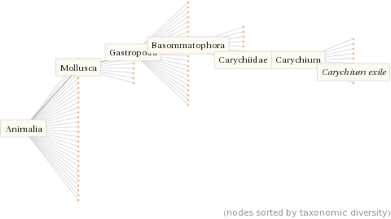Classification

Domain: Species residing in the domain Eukarya possess eukaryotic cells, cells that contain complex structures enclosed within membranes. The defining organelle that sets eukaryotic cells apart from prokaryotic cells is the nucleus in which the genetic material is carried. This characteristic is unique to the domain Eukarya and is the main difference between the other domains: Bacteria and Archaea.
Kingdom: The Animalia kingdom contains animals, which are multicellular organisms composed of eukaryotic cells. These cells are organized into tissues and, unlike the other kingdoms, lack cell walls. Their nutrients are obtained primarily through ingestion and they do not undergo photosynthesis.
Phylum: The phylum Mollusca contains organisms having bilateral symmetry, meaning they can be cut in a sagittal plane into two (left and right) mirror halves. This usually provides for a head (cephalization) and is suited for direction (forward) movement.
Class: The class Gastropoda is the largest and most diverse group of molluscs, containing over 40,000 living species and fossil evidence of over 15,00 extinct species. Unifying characteristics of all gastropods include, having a single spirally coiled shell, undergoing torsion during development, possessing a mantle cavity and muscular foot, and although most are dioecious (possessing either male or female organs, not both) some, such as snails, are hermaphroditic.
Subclass: This subclass is an informal group of snails and slugs characterized by the ability to breathe air. Instead of a gill however, they breathe using a pallial lung. Members of this subclass include land and freshwater families and several marine families.
Order: On their one pair of tentacles, members of the order Basommatophora have their eyes located at the bottom of their tentacles instead of at their tips. The majority of them have shells that are thin, translucent, and virtually colorless. Upon death, the shell turns opaque.
Family: Animals in the this family, Ellobiidae, are pulmonate snails that have a conoidal shell with a tooth-shaped aperture. They are widely distributed in habitats such as salt marshes along tropical and subtropical shores.
Subfamily: The subfamily Carychiidae has members containing a tiny, dull white, cylindrical shell, which appears translucent and thin. Its shell has about 4.5-5 whorls with a height of 1.6-2.5 mm and a width ranging from 0.8-0.9 mm.
Genus: Carychium is a genus of very small air-breathing land snails, terrestrial (residing entirely on land) pulmonate gastropod mollusks.
Species: Carychium exile is a common thorn snail with a single lamella spiraling around the internal spine appearing at the aperture as a single tooth.
This image was taken from WolframAlpha.com and shows the phylogenetic tree associated with the species Carychium exile. It separates from the kingdoms all the way down to the species based on its many characteristics and the morphology of its shell.

